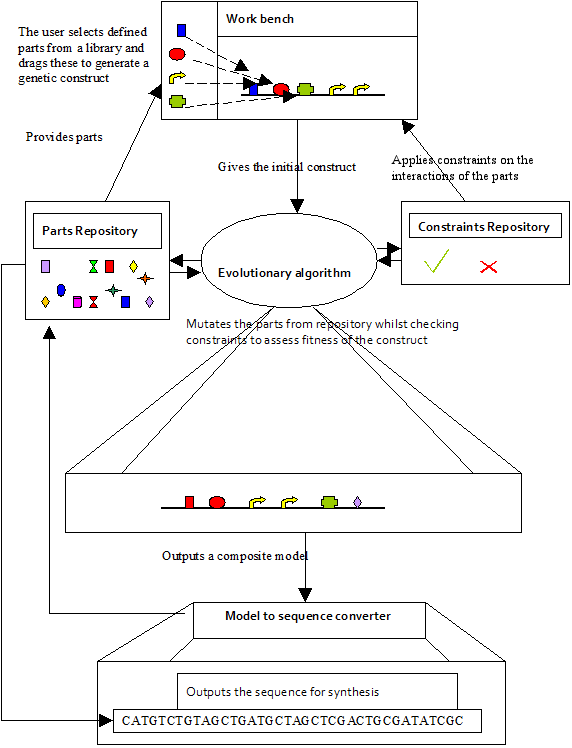Team:Newcastle University/Software
From 2008.igem.org
| (8 intermediate revisions not shown) | |||
| Line 1: | Line 1: | ||
{{:Team:Newcastle University/Header}} | {{:Team:Newcastle University/Header}} | ||
| - | {{:Team:Newcastle University/Template:UnderTheHome|page-title=[[Team:Newcastle University/ | + | {{:Team:Newcastle University/Template:UnderTheHome|page-title=[[Team:Newcastle University/Software|Software]]}} |
| + | |||
| + | Our software consists of four main modules, each providing distinct functionality. These communicate with each other, and with external applications, via Web services. One person was Lead Developer for each module, but the developers worked in the same lab, and had frequent formal and informal discussions in order to develop software which works together and provides the necessary functionality. | ||
==Components== | ==Components== | ||
| + | |||
| + | [[Image:Ncl-software.png|thumb|left|500px|Schematic of the components of the software system. The workbench contains parts provided by the parts repository, and constraints provided by the constraints repository. Parts are selected by the user to create an initial structure for the genetic circuit. Constraints define whether these parts can fit together. The workbench takes a user defined structure, together with a desired behavior, and presents this to the evolutionary algorithm. The evolutionary algorithm evolves potential solutions, starting with the provided structure. It generates a range of potential solutions by requesting different parts from the parts repository, assembling them according to information retrieved from the constraints repository, and assessing the fitness value of the mutated circuit based upon how well this satisfies the objective. Once an acceptable regulatory network has been discovered, this model is sent to the model-to-sequence converter, which uses the parts to derive a DNA sequence that encodes the necessary behaviour, while satisfying sequence constraints, such as avoiding long duplicate regions that could trigger rearrangements in-vivo, or low-complexity regions that would make DNA synthesis more difficult.]] | ||
| + | |||
| + | ===Workbench (Morgan)=== | ||
| + | The Workbench is a graphical front end that allows circuits to be designed by hand, using drag-and-drop of icons, and drawing upon the Parts Repository and the Constraints Repository. The designed circuits can then be sent to the EA to be further refined. | ||
| + | |||
| + | '''[[Team:Newcastle University/Workbench|Workbench]]''' | ||
| + | |||
| + | ===Parts Repository (Megan)=== | ||
| + | The Parts Repository stores information from the literature and various databases about biological parts such as promoters, ribosomal binding sites and protein coding regions. As well as biological information, this includes fragments of CellML that facilitate incorporation of the part into a larger simulation. | ||
'''[[Team:Newcastle University/Parts Repository|Parts Repository]]''' | '''[[Team:Newcastle University/Parts Repository|Parts Repository]]''' | ||
| - | + | ||
| + | ===Constraints Repository (Nina)=== | ||
| + | The Constraints Repository stores information about how parts work together, and associated parameters such as binding affinities, POPS, etc., where these are known. This was populated from the literature and by extracting hard-won knowledge from advisors. | ||
| + | |||
'''[[Team:Newcastle University/Constraints Repository|Constraints Repository]]''' | '''[[Team:Newcastle University/Constraints Repository|Constraints Repository]]''' | ||
| + | |||
| + | ===Evolutionary Algorithm (Mark)=== | ||
| + | The EA takes parts from the Parts Repository, assembles them randomly, but using constraints from the Constraints Repository, and evaluates the "fitness" of the resulting circuit depending on a desired input:output mapping. Equivalent parts with different parameters are swapped in and out at random, and fitter circuits selected in an iterative manner. | ||
'''[[Team:Newcastle University/Evolutionary Algorithm|Evolutionary Algorithm]]''' | '''[[Team:Newcastle University/Evolutionary Algorithm|Evolutionary Algorithm]]''' | ||
| - | + | ||
| + | ==Download== | ||
| + | |||
| + | The software for the above projects is available on the [http://research.ncl.ac.uk/synthetic_biology/ Synthetic Biology at Newcastle] homepage. Due to the size of the projects, they could not be placed on the iGEM wiki. | ||
==Lab Journal== | ==Lab Journal== | ||
[[Team:Newcastle_University/DrylabCalendarHeader|Combined Dry Lab Journal]] | [[Team:Newcastle_University/DrylabCalendarHeader|Combined Dry Lab Journal]] | ||
Latest revision as of 17:54, 29 October 2008
Newcastle University
GOLD MEDAL WINNER 2008
| Home | Team | Original Aims | Software | Modelling | Proof of Concept Brick | Wet Lab | Conclusions |
|---|
Home >> Software
Our software consists of four main modules, each providing distinct functionality. These communicate with each other, and with external applications, via Web services. One person was Lead Developer for each module, but the developers worked in the same lab, and had frequent formal and informal discussions in order to develop software which works together and provides the necessary functionality.
Components

Workbench (Morgan)
The Workbench is a graphical front end that allows circuits to be designed by hand, using drag-and-drop of icons, and drawing upon the Parts Repository and the Constraints Repository. The designed circuits can then be sent to the EA to be further refined.
Parts Repository (Megan)
The Parts Repository stores information from the literature and various databases about biological parts such as promoters, ribosomal binding sites and protein coding regions. As well as biological information, this includes fragments of CellML that facilitate incorporation of the part into a larger simulation.
Constraints Repository (Nina)
The Constraints Repository stores information about how parts work together, and associated parameters such as binding affinities, POPS, etc., where these are known. This was populated from the literature and by extracting hard-won knowledge from advisors.
Evolutionary Algorithm (Mark)
The EA takes parts from the Parts Repository, assembles them randomly, but using constraints from the Constraints Repository, and evaluates the "fitness" of the resulting circuit depending on a desired input:output mapping. Equivalent parts with different parameters are swapped in and out at random, and fitter circuits selected in an iterative manner.
Download
The software for the above projects is available on the [http://research.ncl.ac.uk/synthetic_biology/ Synthetic Biology at Newcastle] homepage. Due to the size of the projects, they could not be placed on the iGEM wiki.
 "
"

